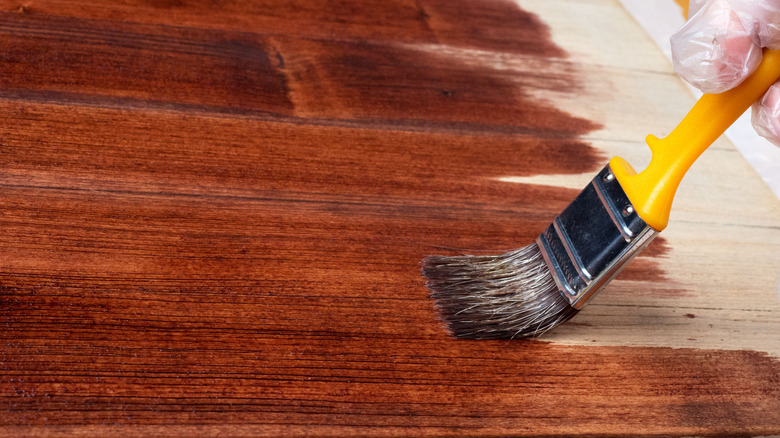The Unexpected Way Glossy French Polish Is Really Made, According To Martha Stewart
Over the years, Martha Stewart has explored an array of home improvement projects, including polishing wood furniture. On an episode of her former television series, "The Martha Stewart Show," the domestic expert spoke with professional furniture maker, Christophe Pourny, about how to apply glossy French polish. While French polish is not actually a product, but rather a process of applying shellac, how it's made may be a little surprising. Often present on antique pieces like dining room tables and chairs, shellac is a resin that is released from the female lac bug. "I don't think people really realize that this is the actual excrement," Stewart explained on "The Martha Stewart Show." Shellac is not made from the actual feces of the lac bug, however.
How is the ultra-shiny polish made? Found in parts of Asia, the lac bug extracts the sap from a tree, then it transforms into a sticky red-infused substance, which is then processed into shellac. "It takes 100,000 of these bugs to make 1 pound [of shellac]," Stewart mentioned. A sublime substance, the insect-derived varnish can be clear or have colors like orange, red, and dark brown. While the process of making glossy French polish is a bit unexpected, the end result is fantastic. Originating in the 17th century, the high-gloss finish was seen as a superior product used on a variety of wooden furniture, including musical instruments. A somewhat lengthy process, you can also achieve this classic look layer by layer with the awe-inspiring, bug-based gloss.
From the lac insect to high-gloss shellac
Found in various forests of India and Thailand, the female lac bug secretes a resin — which is normally used to create a cocoon — that has become the main ingredient of the shellac known as glossy French polish. The amber-like resin is then dried into flakes. But before you can start varnishing your vintage wooden pieces or areas, the lac flakes must be combined with denatured alcohol to become shellac. Add a few tablespoons to about a cup of the crusted pieces, stir it gently, then let it sit and liquefy overnight. "I love shellac. I like the smell, I like what it does," Martha Stewart said (via "The Martha Stewart Show").
Once the components have fused, make sure to shake or stir the container thoroughly before applying your shellac. If you want to enhance the color of your polish, you can add a suitable pigment following this merge. You might store your glossy mixture in a mason jar or squirt bottle in a cool place away from light and moisture, as the concoction can last several months. If you don't want to rely on making up the solution, there are pre-made formulas available in 1-quart cans, including 12-ounce spray canisters.
Applying glossy French polish is rewarding
With some basic tools, applying shellac is fairly easy, although it requires the right consistency and patience. "It's a very rewarding and exciting process," Martha Stewart said (via "The Martha Stewart Show"). A meticulous art form, start by wiping down the surface with alcohol, then coat it with a layer of shellac. "Don't put it right on the wood, put it on a rag," Stewart explained while using a piece of cheesecloth. You can also dab a bit onto a paintbrush or cotton rag, then work it onto the surface in upward and downward movements.
For a fine, hand-rubbed finish, apply powdered pumice stone onto the surface using a felt rubbing pad — you might also utilize pieces of cotton or wool tucked up in a soft rag. Sprinkle the flour-like substance onto the wood while adding more alcohol to your dabber, then rub it on repeatedly — this step can be done over a one- to two-week time period. Then, use a fresh applicator like a cotton T-shirt to apply the final shellac coatings in a circular motion. You may repeat this procedure up to 20 times. "And what emerges is this finish that's like soft silk," Stewart said. With a little help from our friend the lac bug, shellac is a timeless feature that continues to amaze us. However, it's not completely resilient, especially in humid areas like the bathroom and kitchen, where moisture can create white marks.


